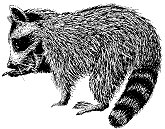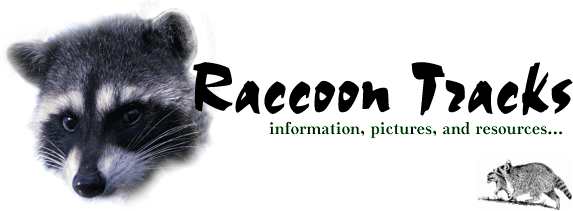|
GENERAL RACCOON FACTS
The common raccoon (Procyon lotor) [PRO-sie-on LO-tor] is the familiar masked
bandit found throughout most of the United States. Procyon means "before
dog" and lotor means "washer." They are found virtually wherever
there is water, from the cold temperate regions of North America to the tropics.
[1] The range of the raccoon is from as high as one mile or more in elevation,
down to the edge of the sea, even to parts of the desert, where there is still access
to water. [2] This warm-blooded mammal is about as big as a medium-sized dog. The "bear's
little brother" is a name given to the raccoon because they are distantly related
to the bear family. Walking on all four feet with an arch in its back and non-retractable
claws, it uses the whole sole of the foot "heel to toe" as it walks, like
man and  all other Plantigrade species.
[3] Their foxlike face tapers to a pointed muzzle. Both their forepaws and
hind feet have five toes. In fact, the ability to grasp and open all manner of zippers,
purses, as well as commanding the manual dexterity to remove the laces from shoes,
are common to the raccoon. Harriet Weaver, California's first lady ranger, who was
stationed at Big Basin State Park -- 67 miles south of San Francisco, and famous
for its ancient, giant redwoods -- gave her advice to a nine-year-old boy concerning
the keeping of a baby raccoon as a pet: "He's got to live in a forest or a stream
bottom, and go wild when the time comes... Only a person who lives out in the country
or next to a game preserve would stand a chance of raising an animal such as this."
[4] She noticed that the young raccoon that she was rehabilitating to return
to the wild seemed to notice himself in the reflection of a pool of water. [5]
Scientists presently believe that only humans, great apes, and dolphins share the
true ability of mirror self-recognition, according to a May 1, 2001 news article,
"Dolphin Self-Recognition Mirrors Our Own," in Scientific American.
[6] all other Plantigrade species.
[3] Their foxlike face tapers to a pointed muzzle. Both their forepaws and
hind feet have five toes. In fact, the ability to grasp and open all manner of zippers,
purses, as well as commanding the manual dexterity to remove the laces from shoes,
are common to the raccoon. Harriet Weaver, California's first lady ranger, who was
stationed at Big Basin State Park -- 67 miles south of San Francisco, and famous
for its ancient, giant redwoods -- gave her advice to a nine-year-old boy concerning
the keeping of a baby raccoon as a pet: "He's got to live in a forest or a stream
bottom, and go wild when the time comes... Only a person who lives out in the country
or next to a game preserve would stand a chance of raising an animal such as this."
[4] She noticed that the young raccoon that she was rehabilitating to return
to the wild seemed to notice himself in the reflection of a pool of water. [5]
Scientists presently believe that only humans, great apes, and dolphins share the
true ability of mirror self-recognition, according to a May 1, 2001 news article,
"Dolphin Self-Recognition Mirrors Our Own," in Scientific American.
[6]
A baby raccoon's eyes do not open until about three weeks. Ranger Weaver's foundling
raccoon -- Frosty -- was fed with a baby bottle using warm evaporated milk, water,
and a few drops of honey, then, burped like a baby. Carefully, she prepared the young
raccoon to return to the wild, finding that Frosty was terrified, until his mating
instinct finally, successfully took hold. The raccoon baby is known as a kit. The
raccoons' procyonid relatives are members of the order Carnivora, which includes
dogs, cats, and bears. [7] The intelligence and dexterity of a raccoon is such that it can pick an
avocado from a tree, aim, and throw it at a barking dog. Door knobs that can be turned
-- without locks -- are no obstacle for a raccoon to open. Some raccoons seem to
possess enough natural intelligence to follow the action events of what they see
portrayed on television. North American Indians called the raccoon -- aroughcun
-- which translates, "he who scratches with his hands." The present name
of raccoon comes from its Indian name aroughcun, which Captain John Smith
used to describe the animal in his Generall Historie of Virginia (1624): "There
is a beast they call aroughcun [raccoon], much like a badger, but useth to
live [in] trees as squirrels do. Their squirrels some are near as great as our smallest
sort of wild rabbits, some blackish or black and white, but the most are gray."
[8] The German name for raccoon is waschbaren ("wash bear"),
while the French call the raccoon raton laveur ("little washing rat").
[9] Raccoons are good climbers, but unlike monkeys, their tail is nonprehensile,
i.e., cannot seize and grasp. When climbing down from a tree, the raccoon backs down,
except for the last few steps, when it turns around. Swimming comes easily to the
raccoon, who uses water for hunting; and, they have been known to drown dogs, who
have pursued them into the water.
Raccoons are survivors. In 1956, this National Geographic writer fitly summarized
the seemingly unsinkable raccoon: "If men cut a raccoon's wood down to build
a summer cottage, they can expect the animal to come and live in the fireplace chimney.
Fill in the creek where raccoons catch shiners and chubs, and you will hear your
garbage cans go rattling over at midnight. Pour concrete, and raccoons will make
themselves at home in the culverts under the road. Raccoons take civilization in
stride and grow fat where lampposts have replaced trees." Raccoons tend to be
solitary. In populated areas, raccoons often choose to make homes in chimney flues
and attics. They seem to be the perennial, nightly raider of the suburban garbage
can. Mating season for the raccoon is at its peak in February and March. The male's
loyalty to the female lasts about a week before its off to find another mate. The
female raises the litter -- which can be as small as 2, or as many as 7 -- of cubs
or kits alone. Pregnancy takes 63 days, and the female usually mates only once in
a season. Raccoon kits are generally born between April and June. Life expectancy
in the wild is about 5 years, while in captivity, it can be up to 20 years. When
a raccoon is in a defensive posture, they take up a "hump-rumped" position,
with their head and ears leveled against their body, complete with a throaty growl.
Suddenly picking up even a tame raccoon from behind will probably cause it to turn
"around in his skin" and bite you. [10] Coon hunting season takes places in
late autumn. Hunters use dogs to chase their quarry up trees -- usually at night
-- to shoot the raccoons in the branches. Though as many as four million are trapped
or hunted each year in the United States, the raccoon population seems only to be
increasing. [11]
back home

Copyright © 2005 Raccoon Pictures & Facts
While this website has no affiliation with Havahart®, the
humane treatment of animals is encouraged!
Member of Fohn.net
|
